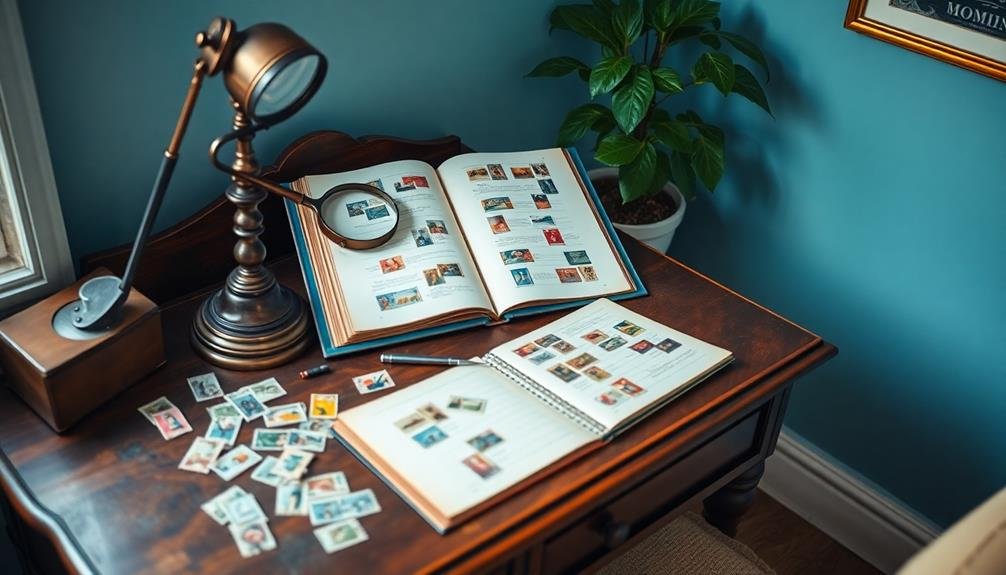Stamp collecting offers numerous techniques to alleviate anxiety. You can practice mindful sorting, focusing on each stamp's details to stay present. Color-based categorization creates a visually soothing collection, while thematic album creation engages your interests. Try magnification meditation to explore intricate designs and calm your mind. Researching stamp history provides a mental escape, and organized storage systems bring order to chaos. Joining stamp trading communities connects you with like-minded individuals. Philatelic journaling helps process emotions, and slow cataloging promotes relaxation. These methods not only build your collection but also cultivate mindfulness and peace. Explore further to uncover how each technique can transform your collecting experience into a therapeutic journey.
Mindful Stamp Sorting

Focusing intently on each stamp, mindful sorting offers a calming escape from everyday stressors. As you engage in this practice, you'll find yourself fully present in the moment, letting go of worries and anxious thoughts.
Start by gathering your stamps and finding a quiet, comfortable space. Take a deep breath and pick up a stamp. Examine its colors, design, and texture. Notice the tiny details you might've missed before. As you sort, categorize stamps based on criteria like country of origin, year, or theme.
Don't rush the process. Let your mind settle on each stamp, appreciating its unique qualities. If your thoughts wander, gently bring your focus back to the task at hand. This mindful approach helps train your brain to stay present, reducing anxiety over time.
As you continue sorting, you'll likely find a sense of order and accomplishment. This can be particularly soothing if you're feeling overwhelmed in other areas of life.
Color-Based Categorization
You'll find the Rainbow Sorting Method particularly soothing as you arrange stamps in a spectrum from red to violet.
This technique not only creates visually appealing collections but also allows you to explore your emotional connections to different hues.
As you categorize stamps by color, you'll naturally associate certain shades with specific moods or memories, enhancing your stamp collecting experience.
Rainbow Sorting Method
One effective technique for organizing your stamp collection is the Rainbow Sorting Method. This approach builds on color-based categorization by arranging stamps in a spectrum-like sequence. You'll start with reds, progressing through oranges, yellows, greens, blues, indigos, and violets. This visually appealing method not only creates a stunning display but also helps reduce anxiety through its orderly structure.
To begin, sort your stamps into primary color groups. Then, within each group, arrange them by shade intensity. For red stamps, you might start with pale pinks, move to bright reds, and end with deep burgundies. This gradual progression creates a soothing visual flow.
The Rainbow Sorting Method offers flexibility, allowing you to incorporate multicolored stamps where they best fit. You can place them between two dominant colors or create a separate "rainbow" section for stamps that encompass multiple hues.
As you engage in this sorting process, you'll find it meditative and calming. The act of focusing on colors and creating harmony can greatly reduce stress and anxiety, making stamp collecting a therapeutic hobby.
Emotional Hue Associations
While the Rainbow Sorting Method focuses on visual appeal, Emotional Hue Associations take color-based categorization to a deeper, more personal level. This technique encourages you to connect colors with emotions, creating a unique and therapeutic organizing system for your stamps.
Start by identifying the dominant colors in your stamp collection. Then, reflect on the emotions each color evokes for you. For example, you might associate blue with calmness, red with excitement, or green with growth.
As you sort your stamps, place them in categories based on these emotional connections. This method not only helps organize your collection but also serves as a form of color therapy. When you're feeling anxious, you can focus on stamps in colors that bring you comfort or joy.
You'll find that this process of associating colors with emotions can be incredibly soothing and introspective. To enhance the experience, consider creating a color-emotion chart for reference.
This will help you maintain consistency in your categorization and serve as a visual reminder of your emotional landscape. As you engage with your stamps through this lens, you'll develop a more profound connection to your collection and potentially gain insights into your emotional state.
Thematic Album Creation

Creating thematic stamp albums can be a deeply satisfying aspect of your collecting journey.
You'll want to select themes that resonate with your personal interests, such as wildlife, sports, or historical events.
Once you've chosen your themes, you can begin organizing your stamps into cohesive collections that tell a story or represent a specific subject matter.
Choosing Engaging Themes
Thematic album creation offers stamp collectors a powerful way to focus their hobby and calm anxious thoughts. When choosing engaging themes for your collection, consider your personal interests and passions. Select topics that resonate with you emotionally or intellectually, as these will provide the most satisfaction and anxiety relief.
Start by brainstorming ideas that excite you, such as nature, history, art, or technology. You can narrow down broad themes into specific sub-categories. For example, if you're interested in animals, you might focus on endangered species or marine life. Historical themes could include ancient civilizations or significant events like the moon landing.
Consider the availability of stamps related to your chosen theme. Some topics may have limited options, while others offer a wealth of material to collect. You can research online catalogs or visit local stamp shops to gauge the scope of your potential theme.
Don't be afraid to think creatively. You can combine multiple themes or create unique categories based on color, shape, or design elements. The key is to choose a theme that captivates your attention and provides a sense of purpose to your collecting journey.
Organizing Thematic Collections
Once you've selected an engaging theme, it's time to bring your collection to life through thoughtful organization. Start by acquiring a thematic album or creating your own using acid-free pages. Divide your album into logical sections based on your theme's subgroups or chronological order.
As you begin arranging your stamps, consider their visual impact. Group similar designs or colors together for a cohesive look. Use clear, archival-quality stamp mounts to protect your stamps while allowing easy viewing. Label each page with relevant information, such as the stamp's country of origin, year of issue, and significance to your theme.
Don't forget to leave space for future acquisitions. As your collection grows, you may need to reorganize or expand sections. Include informative write-ups about the stamps and their connection to your theme. This adds depth to your collection and enhances your understanding of the subject.
Consider creating a digital inventory of your collection alongside your physical album. This can help you track your stamps, identify gaps, and plan future purchases.
Magnification Meditation
Have you ever considered that a magnifying glass could be your gateway to mindfulness?
Magnification meditation is a unique technique that combines stamp collecting with mindfulness practices to reduce anxiety. Start by selecting a stamp with intricate details, then grab your magnifying glass and find a quiet, comfortable spot.
Focus on your breathing as you slowly examine the stamp's design. Notice the tiny lines, colors, and patterns that aren't visible to the naked eye. As you explore, let your mind become absorbed in the miniature world before you. If your thoughts wander, gently bring your attention back to the stamp's details.
This practice helps calm your mind by redirecting your focus from anxious thoughts to the present moment. It also enhances your appreciation for the artistry in stamp design.
Try spending 5-10 minutes on this meditation daily, gradually increasing the duration as you become more comfortable.
To maximize the benefits, vary your stamp selection. Choose stamps with different themes, origins, or historical significance. This keeps the practice fresh and engaging, while also expanding your philatelic knowledge.
Stamp History Research

Diving into stamp history research can be a fascinating way to alleviate anxiety. As you explore the stories behind your stamps, you'll find yourself transported to different eras and cultures, effectively shifting your focus away from worries.
Start by selecting a stamp that intrigues you and begin investigating its origin, design, and historical context. Use online databases, philatelic journals, and stamp catalogs to uncover details about the stamp's creation, printing process, and significance.
You'll often discover connections to important events, notable figures, or cultural milestones. As you piece together this information, you're engaging in a mentally stimulating activity that can help calm your mind.
Don't hesitate to reach out to fellow collectors or join online forums to discuss your findings. Sharing your research can be rewarding and may lead to new insights.
Remember to take notes or create a digital archive of your discoveries. This process of organizing information can provide a sense of control and accomplishment, further reducing anxiety.
Gentle Stamp Mounting
When mounting your stamps, you'll need precision tools like tweezers and stamp hinges to guarantee careful placement.
You'll want to use gentle adhesive techniques, such as peelable mounts or hingeless albums, to preserve your stamps' condition.
Always handle your stamps with clean hands and use protective practices like storing them in acid-free environments to maintain their quality.
Precision Tools for Mounting
Precision is key when mounting stamps for your collection. To achieve this, you'll need the right tools. Start with a pair of stamp tongs, which allow you to handle stamps delicately without touching them directly. Choose tongs with smooth, rounded tips to prevent damage.
A magnifying glass is essential for examining stamps closely and ensuring accurate placement. Opt for a loupe with 10x magnification for ideal viewing. You'll also need a high-quality mounting hinge or mount cutter. Pre-folded hinges save time, while mount cutters let you customize sizes for irregularly shaped stamps.
Invest in a good quality stamp album with acid-free pages to protect your collection long-term. A ruler or alignment guide helps you position stamps precisely on the page. For measuring perforations, a perforation gauge is indispensable.
Don't forget about lighting. A desk lamp with adjustable brightness and color temperature will help you see details clearly without straining your eyes.
Gentle Adhesive Techniques
Now that you have the right tools, it's time to focus on gentle adhesive techniques for mounting your stamps. The key is to use minimal adhesive to protect your stamps' integrity while securing them in place.
Start by selecting acid-free, archival-quality hinges or mounts designed specifically for philately.
For hinged mounting, moisten only a small portion of the hinge with water using a damp sponge. Attach the shorter end to the back of the stamp, near the top edge. Once dry, affix the longer end to your album page. This method allows you to easily remove the stamp if needed.
For hingeless mounting, use clear, plastic mounts cut to size. Carefully slide the stamp into the mount, ensuring it's centered and straight.
Then, apply a small amount of adhesive to the back of the mount and place it on your album page.
Protective Handling Practices
Gentle hands are the cornerstone of protective stamp handling practices. When you're working with your stamps, always use clean, dry hands or wear soft, lint-free gloves to prevent oils and dirt from transferring to your collection.
Handle stamps by their edges, never touching the face or gummed side.
Invest in high-quality tweezers designed specifically for philately. These have flat, smooth tips that won't damage delicate stamps. When using tweezers, grip stamps lightly to avoid creasing or tearing.
Store your stamps in a cool, dry place away from direct sunlight. Use acid-free albums or stock books to prevent yellowing and deterioration. If you're mounting stamps, opt for hingeless mounts or carefully apply hinges to the top third of the stamp's reverse side.
For valuable or fragile stamps, consider using crystal clear protective sleeves. These allow you to examine the stamp without direct contact. When displaying stamps, use UV-resistant frames to protect against fading.
Regularly inspect your collection for signs of damage or pest infestation. If you notice any issues, address them promptly to prevent further deterioration.
Organized Storage Systems

An organized storage system forms the backbone of any successful stamp collection.
You'll find that proper storage not only preserves your stamps but also helps manage anxiety by creating order and reducing clutter.
Start with a high-quality stamp album or stockbook. These provide a secure foundation for your collection and allow for easy viewing. Choose acid-free pages to prevent damage over time.
Organize your stamps by country, year, or theme, whichever method calms your mind best.
For loose stamps, invest in glassine envelopes or stock cards. They're perfect for temporary storage and protect stamps from dust and moisture.
Label each envelope clearly to maintain organization.
Consider using a filing system for your philatelic materials. Dedicate folders to different aspects of your collection, such as research notes, duplicate stamps, or works in progress.
This approach helps you stay focused and reduces overwhelming feelings.
Don't forget about proper environmental conditions. Store your collection in a cool, dry place away from direct sunlight.
Use a dehumidifier if necessary to prevent moisture damage.
Stamp Trading Communities
While organizing your collection provides structure, engaging with other collectors can greatly enhance your stamp collecting experience and alleviate anxiety.
Stamp trading communities offer a supportive environment where you can connect with like-minded individuals who share your passion. You'll find these communities both online and offline, each offering unique benefits.
Online forums and social media groups allow you to interact with collectors worldwide, exchanging knowledge and trading stamps from the comfort of your home. Websites like StampWorld and Colnect provide platforms for virtual trades and discussions.
Local stamp clubs offer face-to-face interactions, where you can attend meetings, participate in auctions, and build friendships with fellow enthusiasts in your area.
Philatelic Journaling

Philatelic journaling offers a therapeutic way to document your stamp collecting journey and manage anxiety. It's a practice that combines the calming effects of writing with the joy of philately.
To start, choose a journal that inspires you and dedicate it solely to your stamp collecting experiences.
Begin by recording details about each stamp you acquire, including its origin, year of issue, and any historical significance. Don't forget to note your personal thoughts and feelings about the stamp. This reflection can help you process emotions and reduce stress.
Include sketches or rubbings of your favorite stamps to engage your creative side. You can also use your journal to plan future acquisitions or document your attendance at stamp shows and exhibitions.
Consider creating themed entries, such as "stamps from countries I've visited" or "my favorite nature-themed stamps."
As you continue journaling, you'll notice patterns in your collecting habits and interests. This self-awareness can be incredibly grounding during anxious moments.
Slow Stamp Cataloging
Slow stamp cataloging offers a meditative approach to organizing your collection, building on the reflective nature of philatelic journaling. This technique involves carefully examining each stamp, taking your time to appreciate its details, and methodically recording its information.
To begin, set aside a quiet space and gather your stamps, a magnifying glass, and your chosen cataloging system. Select a small group of stamps to focus on, perhaps from a specific country or era. Examine each stamp individually, noting its design, colors, and any unique features. Use your magnifying glass to spot hidden details or variations.
As you catalog, record essential information like the stamp's issue date, denomination, and condition. Don't rush this process; instead, let yourself become fully absorbed in each stamp's characteristics. This slow, deliberate approach can help calm your mind and reduce anxiety.
Consider creating a personal rating system for your stamps based on their aesthetic appeal or historical significance. This adds a layer of engagement to the process and helps you develop a deeper connection with your collection.
Frequently Asked Questions
Can Stamp Collecting Help With Other Mental Health Issues Besides Anxiety?
Yes, stamp collecting can help with various mental health issues. It's a calming hobby that can improve focus, reduce stress, and boost self-esteem. You'll find it can also alleviate symptoms of depression and OCD in some cases.
How Much Money Should I Budget for Starting a Stamp Collection?
You can start a stamp collection on a modest budget. Begin with $50-$100 for basic supplies like albums, tongs, and a magnifying glass. Then, allocate $20-$50 monthly for stamps, depending on your interests and collecting goals.
Are There Any Risks or Potential Drawbacks to Stamp Collecting?
You'll face potential risks like overspending, forgeries, and storage issues. You might become obsessed, neglecting other aspects of life. There's also a risk of damaging valuable stamps if you're not careful with handling and preservation techniques.
Can Children Benefit From Stamp Collecting as an Anxiety Relief Technique?
Yes, children can benefit from stamp collecting for anxiety relief. It'll help them focus, develop patience, and learn about history and geography. You'll see improvements in their organizational skills and attention to detail as they enjoy this calming hobby.
How Can I Incorporate Technology Into My Stamp Collecting Hobby?
You can enhance your stamp collecting hobby with technology by using digital cataloging apps, online marketplaces, and virtual communities. You'll also benefit from high-resolution scanners to digitize your collection and specialized software for organizing and researching stamps.
In Summary
You've now discovered ten effective techniques to use stamp collecting as a tool for anxiety relief. Whether you're sorting mindfully, categorizing by color, or diving into stamp history, you'll find these methods engaging and calming. Remember, it's not just about building a collection; it's about creating a peaceful ritual. So, next time you're feeling stressed, turn to your stamps. They're more than just tiny pieces of paper—they're your ticket to tranquility and focus.





Leave a Reply